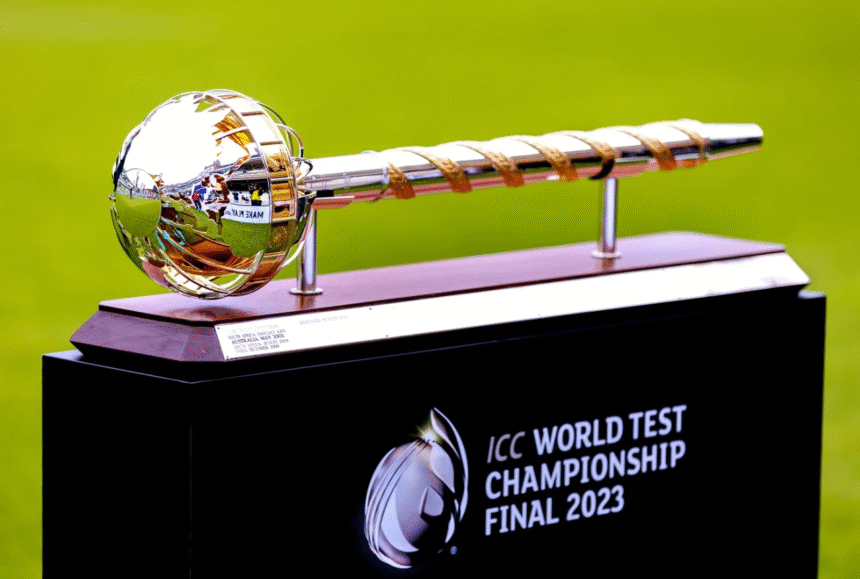World Test Championship, Test cricket is often described as the ultimate test of skill, endurance, and mental strength. But for years, fans complained about the lack of context in bilateral series. Enter the World Test Championship (WTC)—a revolutionary move by the ICC in 2019 to give meaning to every red-ball battle.
Now in its third cycle (2023-25), the WTC has undergone some crucial changes, especially in how points are awarded. Whether you’re a passionate follower of the game or a casual observer, understanding the WTC points system and its evolution can give you a clearer picture of who’s leading the race to the final and why.
Let’s break it down.
What is the World Test Championship?
The ICC World Test Championship is essentially the Test cricket league system aimed at adding competitive context to bilateral Test series. The first cycle ran from 2019 to 2021, culminating in a historic final between India and New Zealand in Southampton, which the Kiwis won.
The WTC cycles are designed to span two years. Each participating team plays six series—three at home and three away—against mutually agreed opponents. The top two teams at the end of the cycle qualify for the WTC Final, hosted at a neutral venue.
How the WTC Points System Works in 2023-25
The current WTC cycle (2023-25) maintains the percentage-based points system introduced during the COVID-affected 2019-21 cycle, but it also brings a more simplified structure.
Here’s how points are awarded:
- 12 points for a win
- 6 points for a tie
- 4 points for a draw
- 0 points for a loss
Each team’s position on the table is based on their percentage of points won (PCT), rather than just the total points. This ensures fairness, especially when teams play unequal number of Tests.
Why Use PCT Instead of Total Points?
During the initial WTC cycle, all teams were to play an equal number of matches (six series). However, COVID-19 disruptions caused many series to be cancelled or shortened. To account for this, the ICC shifted to the percentage of points won rather than total points—a rule that still stands to ensure fairness.
WTC 2019-21 vs. WTC 2021-23 vs. WTC 2023-25: What’s Change?
Let’s take a comparative look at the evolution of the points system across the three cycles.
| Cycle | Points System | Key Feature |
|---|---|---|
| 2019-21 | 120 points per series (split equally among matches) | Complicated, led to imbalance |
| 2021-23 | Fixed points per match (Win: 12, Draw: 4, Tie: 6) + PCT used | Simpler and fairer |
| 2023-25 | Same as 2021-23 | Continuity + more clarity |

So, no major changes were made to the format between 2021-23 and 2023-25—but that’s a good thing. The ICC has stuck with a system that’s easier for fans to understand and fairer in terms of competition.
How Is PCT Calculated?
The PCT (Percentage of Points Won) is calculated using this formula:
PCT = (Points Earned / Points Available) x 100
Let’s say a team plays 10 matches in the cycle and wins 6 (6 x 12 = 72 points), draws 2 (2 x 4 = 8 points), and loses 2 (0 points). That’s a total of 80 points earn out of a possible 120.
So, the PCT = (80/120) x 100 = 66.67%
This system rewards consistency, rather than simply playing more matches or series.
WTC 2023-25 Fixtures and Teams
The nine participating teams in WTC 2023-25 are:
- India
- Australia
- England
- South Africa
- New Zealand
- Pakistan
- Sri Lanka
- West Indies
- Bangladesh
Each team plays six series—three at home, three away.
Notable Series to Watch:
- India vs Australia (2024) – The Border-Gavaskar Trophy is always intense.
- The Ashes (England vs Australia) – Though not part of this cycle, any overlap will still carry WTC points.
- Pakistan vs Sri Lanka (2023) – Crucial for subcontinental bragging rights.
- South Africa vs New Zealand (2024) – Both fighting for a top-2 finish.
Why the WTC Final Matters
Unlike bilateral series that may not influence global standings, the WTC Final is the ultimate prize in Test cricket. It’s essentially the World Cup of Tests, offering a trophy and bragging rights.
In the first final (2021), New Zealand beat India. In the second final (2023), Australia dominated India at The Oval.
The 2023-25 final, likely scheduled for mid-2025 at Lord’s or The Oval, will once again determine the best Test team in the world.
Player and Fan Reactions to the WTC Format
Many players have welcomed the WTC. Here’s what some have said:
- Virat Kohli: “It gives more importance to every Test match. You can’t afford to take any game lightly.”
- Pat Cummins: “It adds a layer of excitement and meaning. You know you’re playing for something bigger.”
- Kane Williamson: “The WTC Final was one of the proudest moments in New Zealand cricket.”
Fans too are enjoying the competitive edge, as every series now directly influences the world standings.
Criticism and Suggestions for Improvement
Despite its success, the WTC format isn’t perfect. Critics point out:
- Lack of uniformity: Not all teams play each other, which can skew the final standings.
- Uneven series lengths: Some series are 2 matches, some are 5. That means more points are on offer in longer series.
- Dead rubbers: If a team is already out of the WTC race, late matches in the cycle may feel irrelevant.
Possible Improvements:
- Ensure uniform series length, maybe standardize all series to 3 Tests.
- Rotate opponents to ensure more variety in matchups.
- Introduce bonus points for away wins or innings victories to spice things up.
Quick Recap – Key Points
- WTC adds context to bilateral Test cricket.
- Points system now awards 12 for a win, 4 for a draw, and uses PCT for rankings.
- No major changes since 2021, just improved clarity and fairness.
- Each team plays 6 series (3 home, 3 away).
- Final between top 2 teams will be in mid-2025.
- Still evolving, but already a success among players and fans alike.
Read More: Virat Kohli Test Cricket Legacy: A Journey of Dominance, Discipline & Determination
Conclusion
The World Test Championship has breathed new life into Test cricket. With a clearer points system, heightened competition, and a coveted final, Test matches are no longer just about tradition—they’re about winning a global title.
As the 2023-25 cycle unfolds, keep an eye on the points table, cheer for your team, and remember—every ball now counts for something far bigger.







